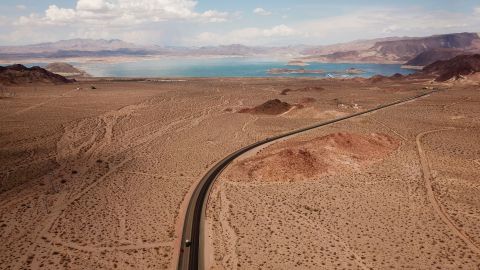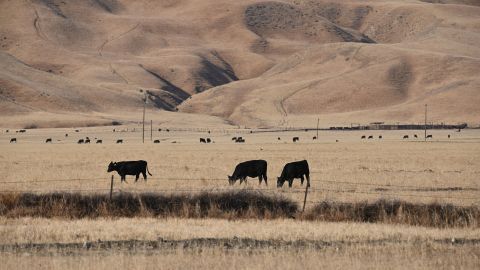As the American West continues into its 22nd year of a parching megadrought, officials at the federal government’s top water resource management agency are trying to plan for an uncertain and unprecedented time for the nation’s largest reservoirs.
“When [the system] was built 100 years ago, you could look outside your window if you’re in Colorado and see snow, and know that that’s your reservoir for the spring,” Bureau of Reclamation Commissioner Camille Touton told CNN in an exclusive interview. “It’s not like that anymore. What you’re seeing there is just a completely different way in which the system is managed.”
Winter weather conditions in the West have been, in a word, inconsistent.
After California’s Sierra Nevada mountains were blanketed by 17 feet of snow in late December, the state then experienced one of its driest Januarys on record. Denver went an unusually long stretch with no snow in the early winter before the state saw storms in January.
This lack of consistency and predictability with winter snowpack means Reclamation is “operating in a completely different regime, as we’ve never done before,” Touton told CNN.
“What we’re seeing in 2022 is good snow, generally, in some places – but at the same time, not consistent,” Touton told CNN. “You’re seeing record events, followed by record dry months. Now add to that low reservoir level, because we didn’t get a lot of inflow into our reservoirs last year.”
The bigger picture is stark. The West’s megadrought is the region’s worst in at least 1,200 years, according to a study published Monday, and researchers said the human-caused climate crisis has made the megadrought 72% worse.
Western water experts echoed the concern that the term “drought” may be insufficient to capture the region’s current hydrology. “Aridification” might be more accurate, said Eric Kuhn, a retired former manager of the Colorado River Water Conservation District.
“Are these temporary conditions? We don’t know; the science is suggesting they’re not,” Kuhn said. “It puts Reclamation in a tough situation, because they’re learning how to deal with a changing climate. Operating these systems under deep uncertainty is not what they were designed for.”
Competing for water
The Bureau of Reclamation, situated in the Department of Interior, has a big role to play in how the West manages its declining water resources.
Established in the early 1900s, Reclamation built some of the West’s largest reservoirs and dams. It works with states, Native American tribes, farmers and other stakeholders to manage water, generate electricity from hydroelectric dams and prepare for drought.
Touton is overseeing the bureau at a time when competition over the remaining water resources is intensifying. Last summer, the federal government declared a water shortage on the Colorado River for the first time as Lake Mead’s and Lake Powell’s levels hit new lows.

But a megadrought of this proportion had already been planned for on the Colorado River – a complex, negotiated priority system that favors some water shareholders ahead of others based on need and historical dependence.
“We’ve never been in these conditions before,” Touton said. “But with the partnerships that we’ve had in the basin for decades, there was always a concern that it could get there. And it was planned for and, unfortunately, that’s what we’re seeing now.”
The bureau is due to receive $1.66 billion per year for the next five years from the bipartisan infrastructure law, effectively doubling its yearly budget. Most immediately, that means it can spend $420 million on rural water projects, $245 million for water recycling projects, $100 million each for dam repair and aging infrastructure fixes, and $50 million on drought contingency planning for the region.
Touton said that as Reclamation repairs some aging reservoirs and water facilities, it will also look at new water sources – including capturing stormwater when it rains and treating it to use later.
John Fleck, a Western water expert and professor at University of New Mexico, said that for Reclamation, the challenge of repairing aging water infrastructure pales in comparison with drought contingency planning with states, tribes and farmers.
The Colorado River basin “has a fundamental problem with overallocation of the water,” Fleck told CNN. “These rules that were written down on pieces of paper over 100 years ago promised more water to users in states than the river can actually provide.”
‘A moment of opportunity’
Even in years with decent snowpack, the climate-fueled megadrought has meant the parched ground soaks up what moisture there is faster. That means intense competition for lower levels of water used for drinking, agriculture and electricity generation.
As CNN has reported, the first group of people impacted by Colorado River water cuts will be farmers in Arizona – but municipalities in the state could also see reductions depending on far the river levels fall.

“The vast majority of this water is used for irrigated agriculture across the basin; there’s just no way around the footprint of irrigated agriculture shrinking,” Fleck told CNN.
Kuhn said that in-home water use ultimately doesn’t account for much of the overall usage, as many cities re-treat and recycle water from appliances. Los Angeles, for example, is working on a plan to treat and recycle all of its wastewater.
The bigger problem is how to sustain agriculture and lawns.
“The future of the river is going to be about grass, it’s not going to be about indoor plumbing,” said Kuhn. “The action is outdoors. It’s crops and grasses.”
Last summer, Nevada banned nonfunctional grass that uses up too much water, and some cities are looking at planting native plants and grasses that don’t need constant watering.
Fleck said that even though the drought is anxiety-inducing, it also creates opportunities for the federal government, states and stakeholders to have a realistic conversation about how to save water.
“When the reservoirs are full, people blow it off,” Fleck said. “When they are draining, that’s when these opportunities arise. This creates a moment of opportunity; there are hard decisions to be made.”
Source: www.cnn.com
